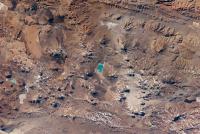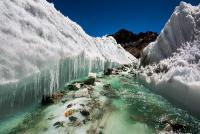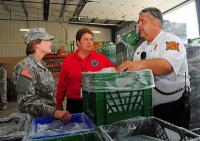-
Civil engineering graduate students awarded scholarships for water research

Three Texas A&M graduate engineering students were recently awarded scholarships to pursue water-related research. The first project will investigate and better define “green water,” which is generally perceived as the soil water available for plants to use, and its potential to alleviate the projected water shortage for Texas agriculture. The second project focuses on future water availability and allocations in the Rio Grande River. The third focuses on the joint effects of climate change, urbanization and flow regulation on water supply in a metropolitan area.
-
-
Toxic chemical found in fish-eating in birds outside of a Georgia’s Superfund site
Researchers have found that a contaminated mixture called Aroclor 1268 has spread beyond a former chemical plant, now a Superfund site, near Brunswick, Georgia. Aroclor 1268 is composed of a suite of toxic chemical compounds known as polychlorinated biphenyls, or PCBs. The chemical was used to produce insulation materials at the Linden Chemical Plant at the Turtle Estuary near Brunswick until 1994.
-
-
Two major U.S. aquifers contaminated with high levels of natural uranium
Nearly two million people throughout the Great Plains and California live above aquifer sites contaminated with natural uranium which is mobilized by human-contributed nitrate. Data from roughly 275,000 groundwater samples in the High Plains and Central Valley aquifers show that many Americans live less than two-thirds of a mile from wells that often far exceed the uranium guideline set by the Environmental Protection Agency. A new study reports that 78 percent of the uranium-contaminated sites were linked to the presence of nitrate, a common groundwater contaminant that originates mainly from chemical fertilizers and animal waste.
-
-
Up to 30 percent less precipitation in the Central Andes in future

Seasonal water shortages already occur in the Central Andes of Peru and Bolivia. By the end of the century, precipitation could fall by up to 30 percent according to an international team of researchers. Researchers show that precipitation in the rainy season could drop noticeably - and this could happen within the next twenty years.
-
-
Warming-driven substantial glacier ice loss in Central Asia imperils water supplies

Central Asia is the outstanding case for human dependence on water seasonally delayed by glaciers. Nowhere the question about the glacier state is linked so closely to questions of water availability and, thus, food security. The glaciers in Central Asia, however, experience substantial losses in glacier mass and area. Along the Tien Shan, Central Asia’s largest mountain range, glaciers have lost 27 percent of their mass and 18 percent of their area during the last fifty years. Scientists estimate that almost 3,000 square kilometers of glaciers and an average of 5.4 gigatons of ice per year have been lost since the 1960s, saying that about half of Tien Shan’s glacier volume could be depleted by the 2050s.
-
-
Toxic blue-green algae a growing threat to nation’s drinking, recreational water
A new report concludes that blooms of toxic cyanobacteria, or blue-green algae, are a poorly monitored and underappreciated risk to recreational and drinking water quality in the United States, and may increasingly pose a global health threat. Several factors are contributing to the concern. Temperatures and carbon dioxide levels have risen, many rivers have been dammed worldwide, and wastewater nutrients or agricultural fertilizers in various situations can cause problems in rivers, lakes, and reservoirs.
-
-
Tackling urban water crises

With drought conditions putting a strain on resources throughout South Florida, FIU researchers are investigating long-term solutions to water crises as part of a newly launched consortium. The Urban Water Innovation Network (UWIN) comprises fourteen academic institutions and key partners across the United States. The UWIN researchers hope to create technological, institutional, and management solutions that will help communities increase the resilience of their water systems and enhance preparedness for responding to water crises.
-
-
Smart hand pumps to bring a reliable water service to rural Africa
Worldwide 780 million people live without basic and reliable water supplies, with parts of rural Africa facing particular challenges achieving water security. Groundwater from hand pumps is a primary water supply for many communities — but up to one third of these pumps are out of action at any one time and can take weeks to be repaired. Researchers have created a device that generates data on hand pump usage and transmits this information over the mobile phone network. The smart hand pump, being trialed in rural Kenya, alerts the maintenance team if the hand pump is not functioning.
-
-
Israel shares its approach, solutions to drought with California
Israel has developed expertise in coping with droughts, and a delegation from Israeli water companies recently visited California, meeting with state officials and corporations to propose solutions to the drought, now in its fourth year. It was the latest in a series of consultations and symposiums highlighting Israeli water expertise and its potential to help California.
-
-
Kosovo’s capital cuts water supplies for fear of ISIS plot to poison reservoir
Kosovo security and health authorities have cut off water supplies to tens of thousands of residents in Pristina, Kosovo’s capital, following a suspicion that ISIS followers had poisoned the city’s water supplies. The city’s water board said supply was cut early on Saturday “because of security issues” and that supplies had been tested for suspicious substances. Police sources say that security officers patrolling the Badovac reservoir saw three of the men behaving suspiciously near the reservoir, and arrested them. They were later identified as ISIS supporters. Kosovar members of ISIS recently appeared in propaganda videos, warning of attacks against targets in the Balkans, including the water supplies of major cities.
-
-
NASA balances water budget with new estimates of liquid assets
Many pressing questions about Earth’s climate revolve around water. With droughts and flooding an ongoing concern, people want to know how much water is on the move and where it is going. To help answer those questions, a new NASA study provides estimates for the global water cycle budget for the first decade of the twenty-first century, taking the pulse of the planet and setting a baseline for future comparisons.
-
-
Crowdsourced computing used to improve water filtration
Nearly 800 million people worldwide do not have access to safe drinking water, and some 2.5 billion people live in precariously unsanitary conditions, according to the Centers for Disease Control and Prevention (CDC). Together, unsafe drinking water and the inadequate supply of water for hygiene purposes contribute to almost 90 percent of all deaths from diarrheal diseases — and effective water sanitation interventions are still challenging scientists and engineers. Researchers propose a novel nanotechnology-based strategy to improve water filtration. The technology involves the minute vibrations of carbon nanotubes called “phonons,” which greatly enhance the diffusion of water through sanitation filters.
-
-
Our mostly dry planetary neighbors once had lots of water -- what does that imply for us?
Our two closest solar system neighbors, Venus and Mars, once had oceans — planet-encircling, globe-girdling, Earth-like oceans, but neither Venus nor Mars could hold onto their water for long enough to nurture advanced life forms until they could flourish. The lessons from Venus and Mars are clear and simple: water worlds are delicate and fragile. Water worlds that can survive the ravages of aging, whether natural or inflicted by their inhabitants — and can nurture and sustain life over the long term — are rare and precious. If we allow the temperature of our planet to rise a degree or two, we may survive it as a minor environmental catastrophe. But beyond a few degrees, if we allow a runaway greenhouse effect to kick up the temperature a few more notches, do we know the point at which global warming sends our atmosphere into a runaway death spiral, turning Earth into Venus? We know what the endgame looks like.
-
-
California Republicans introduce bill to improve Western water reliability
Republican members of the California congressional delegation yesterday introducing a bill to modernize water policies in California and throughout the Western United States. The bill has the support of the entire California Republican delegation, the chairman of the House Natural Resources Committee, and chairman of the Western Caucus. The bill’s authors say that H.R. 2898, the Western Water and American Food Security Act of 2015, aims to make more water available to families, farmers, and communities in California and bordering Western states. The bill takes aim at what the authors describe as the “dedication of vast quantities of water to protect certain species of fish listed under the Endangered Species Act (ESA) [which] is a significant obstacle hindering water delivery in Central and Southern California.” H.R. 2898 will require federal agencies to use current and reliable data when making regulatory decisions, which in turn will provide more water for communities in need.
-
-
Powering desalination with the sun
When graduate student Natasha Wright began her Ph.D. program in mechanical engineering, she had no idea how to remove salt from groundwater to make it more palatable, nor had she ever been to India, where this is an ongoing need. Although the available filters made water safe to drink, they did nothing to mitigate its saltiness — so the villagers’ drinking water tasted bad and eroded pots and pans, providing little motivation to use these filters. Almost 60 percent of India has groundwater that’s noticeably salty, so Wright began designing an electrodialysis desalination system, which uses a difference in electric potential to pull salt out of water.
-
- All
- Regional
- Water
- Biometrics
- Borders/Immig
- Business
- Cybersecurity
- Detection
- Disasters
- Government
- Infrastructure
- International
- Public health
- Public Safety
- Communication interoperabillity
- Emergency services
- Emergency medical services
- Fire
- First response
- IEDs
- Law Enforcement
- Law Enforcement Technology
- Military technology
- Nonlethal weapons
- Nuclear weapons
- Personal protection equipment
- Police
- Notification /alert systems
- Situational awareness
- Weapons systems
- Sci-Tech
- Sector Reports
- Surveillance
- Transportation
Advertising & Marketing: advertise@newswirepubs.com
Editorial: editor@newswirepubs.com
General: info@newswirepubs.com
2010-2011 © News Wire Publications, LLC News Wire Publications, LLC
220 Old Country Road | Suite 200 | Mineola | New York | 11501
Permissions and Policies
Editorial: editor@newswirepubs.com
General: info@newswirepubs.com
2010-2011 © News Wire Publications, LLC News Wire Publications, LLC
220 Old Country Road | Suite 200 | Mineola | New York | 11501
Permissions and Policies
